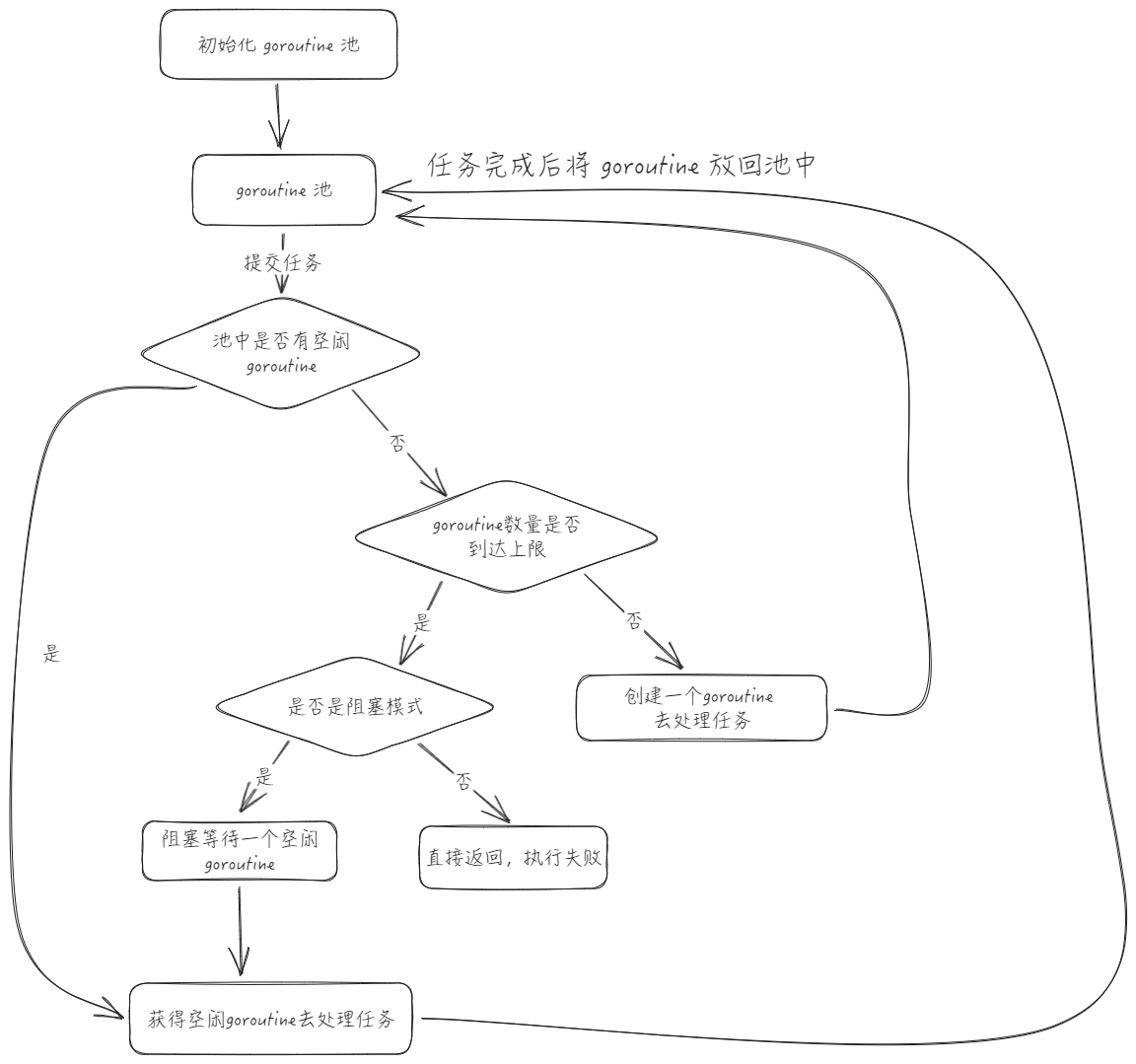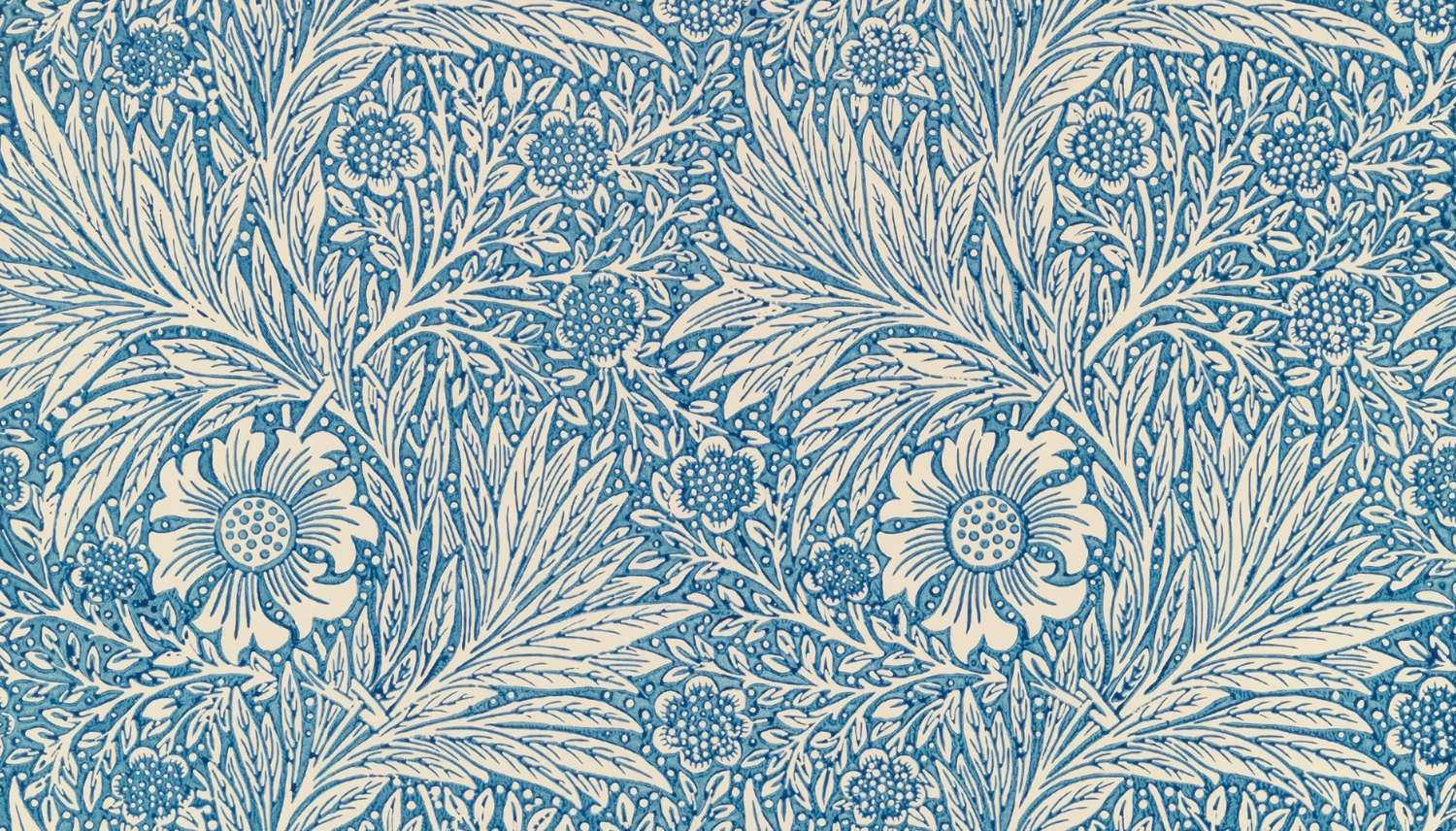ants: 协程池源码学习
是什么
ants是一个高性能的 goroutine 池,实现了对大规模 goroutine 的调度管理、goroutine 复用,允许使用者在开发并发程序的时候限制 goroutine 数量,复用资源,达到更高效执行任务的效果。
解决了什么问题
- 提升性能:主要面向一类场景,大批量轻量级并发任务,任务执行成本与协程创建/销毁成本量级接近
- 并发资源控制:研发能够明确系统全局并发度以及各个模块的并发度上限
- 协程生命周期控制:实时查看当前全局并发的协程数量;有一个统一的紧急入口释放全局协程
带来的价值:
- 限制并发的 goroutine 数量
- 复用 goroutine,减轻 runtime 调度压力,提升程序性能
- 规避过多的 goroutine 侵占系统资源(CPU&内存)
Quick Start
创建 goroutine 池
1 | pool, _ := ants.NewPool(100) |
提交任务
1 | ants.Submit(func(){ |
动态调整容量
1 | pool.Tune(1000) // Tune its capacity to 1000 |
释放资源
1 | pool.Release() |
源码分析
核心结构
架构图中包含了所有核心结构,并展现了分层关系,开发中最为常用的还是 Pool,主要沿着 Pool 这条线进行研究,PoolWithFunc 实现逻辑其实和 Pool 大差不差

pool
1 | // Pool accepts the tasks and process them concurrently, |
Pool 就是所谓的协程池,管理 goroutine,限制 goroutine 数目
- capacity:协程池容量,最大 goroutine 数量限制
- running:正在运行的协程数目
- lock:自制的轻量自旋锁,用于保护 goWorker 队列
- workers:goWorker 队列,真正意义上的协程池,存放着可以复用的 goroutine 资源
- state:协程池状态标识,0-打开;1-关闭
- cond:go中的信号量,是一种 goroutine 同步工具。如果 pool 配置 blocking 模式,则会用于协调 goroutine 的唤醒和挂起
- workerCache:goWorker 对象池,缓存着被释放的 goWorker,用于 goWorker 的资源复用
- waiting:被阻塞的协程数目
- purgeDone:标识释放 goWorker 的协程是否关闭
- stopPurge:用于关闭释放 goWorker 的协程
- ticktockDone:标识时间更新协程是否关闭
- stopTicktock:用于关闭时间更新协程的函数
- now:缓存当前时间,在 goWorker 执行完任务放回 goWorker 队列时需要记录任务完成时间,通过缓存+异步更新的方式,减少 time.Now() 的调用次数
- optons:一些定制化配置
workerQueue
1 | type workerQueue interface { |
workerQueue 是一个接口,定义了数据操作所需的 api
接口的实现有 workerStack 和 loopQueue ,从命名即可看出一个是栈结构一个是循环队列的结构
如果 Pool使用了 PreAlloc 容量预分配配置,会选用 loopQueue 实现,否则会默认选用workerStack 的实现
这里所谓的是否预分配其实指的是他们内部实现中存放 goWorker结构的 slice 容量是否预分配
loopQueue 的容量在创建后就不能够更改了,而workerStack 可以通过 Tune() 方法动态更新容量
继续关注一下 workerStack 的实现
workerStack
1 | type workerStack struct { |
- items:协程池中可用的 goWorker
- expiry:已过期需要清理释放的 goWorker
goWorker
1 | // goWorker is the actual executor who runs the tasks, |
goWorker 是任务真正的执行者,可以认为它代表了协程池中的协程资源
- pool:goWorker 所属的协程池
- task:goWorker 用于接收异步任务的管道
- lastUsed:goWorker 回收到协程池的时间(上一次结束任务运行的时间)
主流程

NewPool 创建协程池
1 | // NewPool instantiates a Pool with customized options. |
NewPool 方法用于创建一个新的协程池
- 校验用户入参,设置 options
- 构造 Pool 数据结构
- 构造 goWorker 对象池
- 构造 goWorker 队列,依据是否预分配注入不同的实现结构
- 构造用于并发控制的 sync.Cond
- 启动负责释放 goWorker 协程
- 启动负责更新 now 的协程
Pool.Submit 提交任务
1 | // Submit submits a task to this pool. |
Pool.Submit 方法的作用是将任务提交给协程池执行
- 检查协程池是否已经关闭,如果关闭则直接返回 err
- 调用 retrieveWorker 从协程池中获取一个可供使用的 goWorker
- 通过 channel 将任务发送给 goWorker 执行
Pool.retrieveWorker 获取可用的goWorker
1 | // retrieveWorker returns an available worker to run the tasks. |
Pool.retrieveWorker 将获取一个空闲的 goWorker 用于任务的执行
- 要操作 workerQueue,所以需要上锁保护
- 调用 workerQueue.detach() 尝试从 workerQueue 中取出一个 goWorker 返回
- 检查当前正在使用的 goWorker 是否到达协程池的容量,如果容量未超出限额,则通过 workerCache 对象池获取并启动一个 goWorker 返回
- 如果容量超出限额,且 Pool 为非阻塞模式,则返回 err
- 如果容量超出限额,且 Pool 为阻塞模式但等待执行的任务数目到达配置的上限,返回 err
- 如果容量超出限额,且 Pool 为阻塞模式但等待执行的任务数目未达上线,则通过 cond 挂起
workerQueue.detach 取出一个 goWorker
这里就关注一下 workerStack 的实现,loopQueue 也是类似的
1 | func (wq *workerStack) detach() worker { |
workerQueue.detach 做的工作其实就是从 slice 中取出最后一个元素,比较简单
值得注意的点是 wq.items[l-1] = nil 这步防止内存泄漏的操作
详细可参考 issue: Avoid memory leak #107
goWorker.run 执行任务
1 | // run starts a goroutine to repeat the process |
阶段一:goWorker 的运行
- 不断从 task channel 中获取任务并执行,任务执行完毕后通过 revertWorker 将 goWorker 结构放回 workerQueue,goroutine 并没有退出而是阻塞等待新任务
- 这里就是对于 goroutine 的复用,也是 ants 高性能的关键
阶段二:goWorker 的释放
- 当前 goWorker 在负责释放 goWorker 协程中被调用 finish 方法,finish 触发 goWorker 销毁的方法是往 task 中注入空值,从 task 中取得 nil,由此进入释放流程
- goWorker 在执行过程中出现 panic,或是回归 workerQueue 失败(例如 Pool 已关闭),也会被 defer 兜底,并进入释放流程
- 将 goWorker 放入 WorkerCache 对象池
- 通过 cond.Signal() 唤醒一个阻塞等待的协程获取 goWorker 启动任务
Pool.revertWorker 回收goWorker
1 | // revertWorker puts a worker back into free pool, recycling the goroutines. |
Pool.revertWorker 负责将 goWorker 放回到 workerQueue 中
- 更新 goWorker 记录的时间 lastUsed,lastUsed 是用于判断闲置的 goWorker 是否应该被回收的依据
- 将 goWorker 放回 workerQueue 中
- 唤醒一个等待的协程取用 goWorker
Pool.goPurge 释放goWorker
1 | func (p *Pool) goPurge() { |
回头看在 Pool.New 中使用 Pool.goPurge 启动的用于释放 goWorker 的协程
- 通过 context.Context 来控制协程的退出
- 使用 Pool.purgeStaleWorkers 启动真正的 goWorker 释放协程
1 | // purgeStaleWorkers clears stale workers periodically, it runs in an individual goroutine, as a scavenger. |
Pool.purgeStaleWorkers 负责 goWorker 的释放工作
- 定时检查 workerQueue 中的 goWorker 是否闲置过长时间,对过期的 goWorker 进行销毁释放
- 对于 goWorker 过期的判断是基于 goWorker.lastUsed 来做的,workerStack 和 loopQueue 这两种 workerQueue 实现中都是通过二分查找的方式来获取过期 goWorker
Pool.Release 释放协程池
1 | // Release closes this pool and releases the worker queue. |
Pool.Release 在协程池不再使用时,用于销毁,释放系统资源
- 通过 atomic 包的原子操作,无锁更新 Pool 的状态,标记为关闭
- 通过 context 关闭辅助协程
- 释放 workerQueue 的资源
- 为了防止有 goroutine 还阻塞在
p.cond.Wait()上,执行一次p.cond.Broadcast()
其他内容
PoolWithFunc
和 Pool 的设计整体上都大差不差
只是 Pool 使用 goWorker 来代表 goroutine 资源,需要传入 func 作为任务执行;而PoolWithFunc 使用 goWorkerWithFunc 来代表 goroutine 资源,所需执行的任务函数在协程池创建时就已经指定,提交任务是需要传入的内容就不是是函数了,而是函数运行的参数
MultiPool
MultiPool 内容会初始化多个协程池,可以根据预先定义的负载均衡策略:轮询或者最少使用策略,从多个协程池中获取 goWorker
Pool 中有保护 workerQueue 的自旋锁,之所以新加了这个,是为了降低锁的颗粒度,以此提高性能
MultiPoolWithFunc
与 MultiPool 之间的关系就和 Pool 和 PoolWithFunc 之间的关系差不多
spinLock 自制的轻量级自旋锁
嫌弃 sync.Mutex 太重了,利用 atomic.CompareAndSwapUint32() 这个原子操作实现了一个自旋锁。
与其他类型的锁不同,自旋锁在加锁失败之后不会立刻进入等待,而是会继续尝试。这对于很快就能获得锁的应用来说能极大提升性能,因为能减少加锁和解锁导致的线程切换
加锁操作中使用了指数退避的算法,连续的抢锁失败会让惩罚增加,runtime.Gosched() 会让当前 goroutine 让出 cpu,减少空转
1 | type spinLock uint32 |
注意事项
💡 使用 ants 的一个理由是通过池子来自动管理 goroutine 的生命周期,不用手动管理
💡 考虑一下提交给协程池的任务中又启动了新协程的情景,读了源码自然能够知道,在这种情况下,这些协程是不受 ants 限制的,还是需要手动管理生命周期。所以避免在提交的任务中启动新协程,或是设计好这些新协程的生命周期管理
💡 ants 擅长处理的任务应当是耗时短但是量大的小任务。对于耗时长和量小的任务而言,体现不出 ants 对于 goroutine 复用的性能提升
参考资料
- 项目地址:panjf2000/ants: 🐜🐜🐜 ants is a high-performance and low-cost goroutine pool in Go. (github.com)
- GMP 并发调度器深度解析之手撸一个高性能 goroutine pool - Strike Freedom (taohuawu.club)
- Visually Understanding Worker Pool | by David | Coinmonks | Medium
- Golang 协程池 Ants 实现原理 (qq.com)
- Go 每日一库之 ants(源码赏析) - 大俊的博客 (darjun.github.io)


